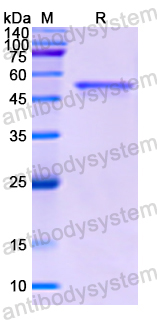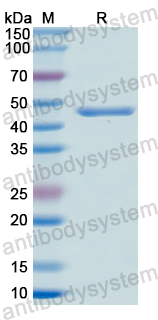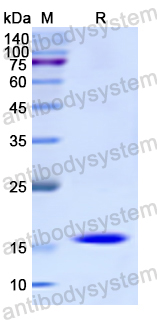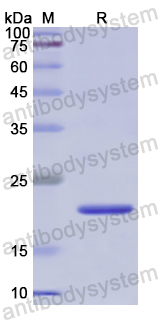Catalog No.
YHF48601
Expression system
E. coli
Species
Homo sapiens (Human)
Protein length
Met1-Leu440
Predicted molecular weight
51.49 kDa
Nature
Recombinant
Endotoxin level
Please contact with the lab for this information.
Purity
>90% as determined by SDS-PAGE.
Accession
P62191
Applications
ELISA, Immunogen, SDS-PAGE, WB, Bioactivity testing in progress
Form
Lyophilized
Storage buffer
Lyophilized from a solution in PBS pH 7.4, 0.02% NLS, 1mM EDTA, 4% Trehalose, 1% Mannitol.
Reconstitution
Reconstitute in sterile water for a stock solution. A copy of datasheet will be provided with the products, please refer to it for details.
Shipping
In general, proteins are provided as lyophilized powder/frozen liquid. They are shipped out with dry ice/blue ice unless customers require otherwise.
Stability and Storage
Use a manual defrost freezer and avoid repeated freeze thaw cycles. Store at 2 to 8°C for frequent use. Store at -20 to -80°C for twelve months from the date of receipt.
Alternative Names
P26s4, 26S proteasome regulatory subunit 4, Proteasome 26S subunit ATPase 1, PSMC1, 26S proteasome AAA-ATPase subunit RPT2
Comprehensive Analysis Reveals Midnolin as a Potential Prognostic, Therapeutic, and Immunological Cancer Biomarker., PMID:40002690
Analyzing the impact of perfluorooctanoic acid (PFOA) and perfluorooctane sulfonate (PFOS) on the reproductive system using network toxicology and molecular docking., PMID:39492895
Nuclear factor erythroid 2-related factor 1 regulates the expression of proteasomal genes in ketotic cows and protects mammary cells against free fatty acid-induced endoplasmic reticulum stress., PMID:39343197
Diminished expression of the ubiquitin-proteasome system in early treatment-naïve patients with rheumatoid arthritis and concomitant type 2 diabetes may be linked to IL-1 pathway hyper-activity; results from PEAC cohort., PMID:39342401
PSMD11 loss-of-function variants correlate with a neurobehavioral phenotype, obesity, and increased interferon response., PMID:38866022
Exploiting bacterial effector proteins to uncover evolutionarily conserved antiviral host machinery., PMID:38753575
IBPGNET: lung adenocarcinoma recurrence prediction based on neural network interpretability., PMID:38557672
ABT199/venetoclax synergism with thiotepa enhances the cytotoxicity of fludarabine, cladribine and busulfan in AML cells., PMID:38484153
Impaired 26S proteasome causes learning and memory deficiency and induces neuroinflammation mediated by NF-κB in mice., PMID:38405714
Exploiting Bacterial Effector Proteins to Uncover Evolutionarily Conserved Antiviral Host Machinery., PMID:38352400
The prognostic value of 19S ATPase proteasome subunits in acute myeloid leukemia and other forms of cancer., PMID:37502358
PSMC3 proteasome subunit variants are associated with neurodevelopmental delay and type I interferon production., PMID:37256937
Soybean ZINC FINGER PROTEIN03 targets two SUPEROXIDE DISMUTASE1s and confers resistance to Phytophthora sojae., PMID:36782397
Genetic Alterations in Members of the Proteasome 26S Subunit, AAA-ATPase (PSMC) Gene Family in the Light of Proteasome Inhibitor Resistance in Multiple Myeloma., PMID:36672481
Genome-wide siRNA screens identify RBBP9 function as a potential target in Fanconi anaemia-deficient head-and-neck squamous cell carcinoma., PMID:36639418
The development of a tumor-associated autoantibodies panel to predict clinical outcomes for immune checkpoint inhibitor-based treatment in patients with advanced non-small-cell lung cancer., PMID:36594104
Evaluating the Prognostic and Therapeutic Potentials of the Proteasome 26S Subunit, ATPase (PSMC) Family of Genes in Lung Adenocarcinoma: A Database Mining Approach., PMID:35938038
PSMC1 variant causes a novel neurological syndrome., PMID:35861243
Molecular clustering based on gene set expression and its relationship with prognosis in patients with lung adenocarcinoma., PMID:35693605
Low expression of TCP1 (T-Complex 1) and PSMC1 (Proteasome 26S subunit, ATPase 1) in heterotopic ossification during ankylosing spondylitis., PMID:34612770
Construction, Identification and Analysis of the Interaction Network of African Swine Fever Virus MGF360-9L with Host Proteins., PMID:34578385
Regulation of the HTRA2 Protease Activity by an Inhibitory Antibody-Derived Peptide Ligand and the Influence on HTRA2-Specific Protein Interaction Networks in Retinal Tissues., PMID:34440217
Prognoses and genomic analyses of proteasome 26S subunit, ATPase (PSMC) family genes in clinical breast cancer., PMID:34329194
The Silence of PSMC6 Inhibits Cell Growth and Metastasis in Lung Adenocarcinoma., PMID:34239933
Low-dose CDK4/6 inhibitors induce presentation of pathway specific MHC ligands as potential targets for cancer immunotherapy., PMID:34104540
14q32.11 microdeletion including CALM1, TTC7B, PSMC1, and RPS6KA5: A new potential cause of developmental and language delay in three unrelated patients., PMID:33634591
Topoisomerase 2β Induces DNA Breaks To Regulate Human Papillomavirus Replication., PMID:33563836
Warming and freshening activate the transcription of genes involved in the cellular stress response in Harpagifer antarcticus., PMID:33523350
Identification of Target Genes in Hypertension and Left Ventricular Remodeling., PMID:32664164
Activation of DNA damage repair factors in HPV positive oropharyngeal cancers., PMID:32560902
Comparison of signaling profiles in the low dose range following low and high LET radiation., PMID:32414491
The Calcineurin-TFEB-p62 Pathway Mediates the Activation of Cardiac Macroautophagy by Proteasomal Malfunction., PMID:32366200
Cellular stress responses of Eleginops maclovinus fish injected with Piscirickettsia salmonis and submitted to thermal stress., PMID:31834618
Inactive USP14 and inactive UCHL5 cause accumulation of distinct ubiquitinated proteins in mammalian cells., PMID:31703099
Differential expression of serum proteins in multiple myeloma., PMID:30651846
Application of a radiosensitivity flow assay in a patient with DNA ligase 4 deficiency., PMID:30061307
Change in Ubiquitin Proteasome System of Grass Carp Ctenopharyngodon idellus Reared in the Different Stocking Densities., PMID:30026700
Assaying Radiosensitivity of Ataxia-Telangiectasia., PMID:28477107
Label-free Proteomic Analysis of Exosomes Derived from Inducible Hepatitis B Virus-Replicating HepAD38 Cell Line., PMID:28242843
FANCD2 Binds Human Papillomavirus Genomes and Associates with a Distinct Set of DNA Repair Proteins to Regulate Viral Replication., PMID:28196964
TOPORS, a Dual E3 Ubiquitin and Sumo1 Ligase, Interacts with 26 S Protease Regulatory Subunit 4, Encoded by the PSMC1 Gene., PMID:26872363
Increased hepatic receptor interacting protein kinase 3 expression due to impaired proteasomal functions contributes to alcohol-induced steatosis and liver injury., PMID:26769846
Candidate genes for carcass traits in a tropical-adapted Brazilian composite beef breed., PMID:26681013
Defining the Biological Effectiveness of Components of High-LET Track Structure., PMID:26114329
Human papillomaviruses activate and recruit SMC1 cohesin proteins for the differentiation-dependent life cycle through association with CTCF insulators., PMID:25875106
Profiling human protein degradome delineates cellular responses to proteasomal inhibition and reveals a feedback mechanism in regulating proteasome homeostasis., PMID:25223703
Proteasome function is required for platelet production., PMID:25061876
Proteasome activation is a mechanism for pyrazolone small molecules displaying therapeutic potential in amyotrophic lateral sclerosis., PMID:25001311
Investigation of the association of two candidate genes (H-FABP and PSMC1) with growth and carcass traits in Qinchuan beef cattle from China., PMID:24668675
NADH binds and stabilizes the 26S proteasomes independent of ATP., PMID:24596095




